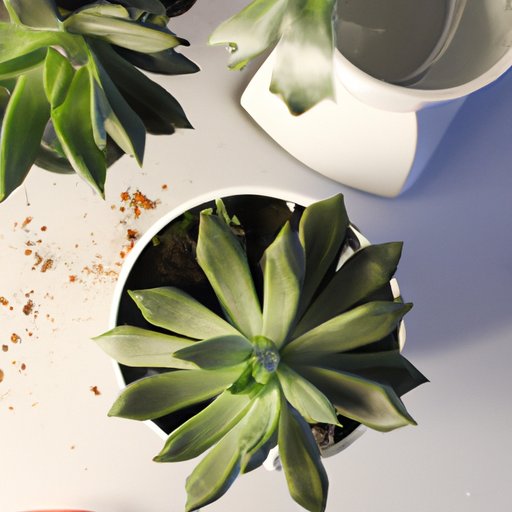Introduction
Succulents are a great addition to any home garden or indoor plant collection. These unique plants come in a variety of shapes, sizes, and colors and can thrive in a range of environments. However, caring for a succulent can be a bit challenging if you’re not familiar with their unique needs. This article will provide a comprehensive guide on how to care for a succulent, including basic information, lighting, watering, feeding, preventing pests and diseases, troubleshooting, and more. Whether you’re a seasoned gardener or a newbie, this guide is perfect for succulent lovers of all levels.
Basics of Succulents
Succulents are plants that store water in their leaves, stems, and roots, allowing them to survive in arid environments. Unlike other plants that require frequent watering, succulents thrive with less water. They are known for their unique shapes and sizes, ranging from small, round rosettes to tall, spiky plants. Some common types of succulents that can be grown at home include aloe vera, agave, jade plant, and cacti.
Lighting Needs
Finding the right lighting is crucial for the health of your succulent. Succulents require bright, indirect light, but too much direct sunlight can be harmful. When choosing the location of your succulent, consider the amount of natural light the area receives. A south-facing window is often the best choice for succulents, but if one is not available, consider using artificial grow lights. Remember to rotate your succulent regularly to ensure even growth, as plants may lean towards the light source.
Watering
One of the biggest misconceptions about succulents is that they thrive on neglect, and don’t require much watering. However, under- or over-watering can be detrimental to your plant’s health. The frequency of watering succulents largely depends on the environment and the type of soil used. Generally, it’s best to water your succulent only when the soil is completely dry. The type of pot and soil blend also play a role in proper watering. Succulents prefer well-draining soil and a pot with drainage holes to prevent root rot.
Feeding
While succulents can survive in less than ideal conditions, they still need nutrients to thrive. Fertilizing your succulent will promote healthy growth and keep it thriving. Choose a balanced fertilizer that is specifically formulated for succulents, and apply as directed. Typically, fertilizing every few months during the growing season is recommended.
Preventing Pests and Diseases
Succulents are not immune to pests and diseases. Common pests that can affect succulents include spider mites, mealybugs, and scale insects. These pests can be removed manually or with an insecticidal soap. Diseases, such as fungal infections, can be prevented by ensuring that your succulent has proper drainage and by avoiding overwatering.
Troubleshooting
Sometimes, despite our best efforts, succulents can experience stresses such as overwatering, under-watering, transplanting impact, and change of environment. When caring for a stressed or damaged succulent, continue to provide the best care possible and avoid introducing any new stressors. Over time, the plant should regain its health. However, if the damage is irreversible, consider trimming the damaged parts.
Conclusion
Succulent care requires some basic knowledge and patience. Understanding the specific needs of your plant and providing proper care can help it thrive for many years. Remember, each succulent has a unique personality and needs, and it’s up to you to provide the best care possible. With this comprehensive guide, you should now have a better understanding of how to care for a succulent with confidence.
